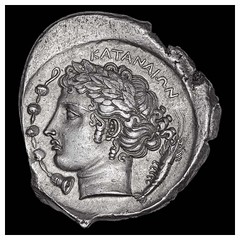
About UsThe Numismatic Bibliomania Society is a non-profit organization promoting numismatic literature. For more information please see our web site at coinbooks.org SubscriptionsThose wishing to become new E-Sylum subscribers (or wishing to Unsubscribe) can go to the following web page link MembershipThere is a membership application available on the web site Membership Application To join, print the application and return it with your check to the address printed on the application. Membership is only $15 to addresses in the U.S., $20 for First Class mail, and $25 elsewhere. For those without web access, write to: David M. Sundman, Treasurer AsylumFor Asylum mailing address changes and other membership questions, contact David at this email address: dsundman@LittletonCoin.com SubmissionsTo submit items for publication in The E-Sylum, just Reply to this message, or write to the Editor at this address: whomren@gmail.com
BUY THE BOOK BEFORE THE COIN |
- WAYNE'S WORDS: THE E-SYLUM SEPTEMBER 15, 2013
- NEW BOOKS: THE MEDALS OF KARL X. GOETZ
- NEW BOOK: COMPLETE COINAGE OF SEPTIMUS SEVERUS
- NEW BOOK: MEDALLIC HISTORY OF THE WAR OF 1812
- NEW BOOK: SYLLOGE NUMMORUM PARTHICORUM
- NEW BOOK: CAMBODIA COINS AND CURRENCY
- NEW BOOK: THE ENGLISH CIVIL WARS
- COLORADO FLOODS BYPASS E-SYLUM SERVERS
- READERS REMEMBER ERIC VON KLINGER
- MORE ON 'NUMISMATIC TIMES AND TRENDS'
- NOTES FROM E-SYLUM READERS: SEPTEMBER 15, 2013
- MORE ON CREATESPACE AND AMAZON PRICING
- WEB SITES FOR OLD MAGAZINES
- 16TH STREET BAPTIST CHURCH BOMBING VICTIMS MEDAL
- ELDER SOLD LARGE-PAPER VERSION OF ATTINELLI’S NUMISGRAPHICS
- HUB AND DIE MAKING AT THE PHILADELPHIA MINT
- SCHULER GROUP: COIN PRESS MAKER TO THE WORLD
- LOTS FROM THE KOLBE-FANNING SALE #130: FISHER, MEHL'S MONTHLY
- MEDALS STRUCK WITH CANCELLED 1995 OLYMPIC DOLLAR DIE
- MORE ON THE ERIC THE RED LIFESAVING MEDAL
- WHAT IS THE VALUE OF A MEDAL OF HONOR?
- WELSH SPORTS HALL OF FAME ACQUIRES 1893 TRIPLE CROWN GOLD MEDAL
- BANK OF ENGLAND TO RELEASE POLYMER BANKNOTES IN 2016
- NEW 'QUANTUM' SENSOR DETECTS COUNTERFEIT BANKNOTES
- STUDY WARNS OF NICKEL ALLERGY AND NEW ROYAL MINT COINS
- THE SHEKEL WINS FIRST PLACE SPECIALTY CLUB PUBLICATION AWARD
- WAYNE'S NUMISMATIC DIARY: SEPTEMBER 15, 2013
- FEATURED WEB PAGE: COINS OF LAOS
Click here to access the complete archive
To comment or submit articles, reply to whomren@gmail.com
WAYNE'S WORDS: THE E-SYLUM SEPTEMBER 15, 2013

New subscribers this week include David Hall and Don Willis, courtesy of Ron Guth, plus S. Seiler and Mel Wacks. Welcome aboard! We have 1,681 email subscribers, plus 246 followers on Facebook.
This week we open with word of SIX new numismatic books. What a great time to be a bibliophile! This is a great batch of titles, and comes on top of several great new books announced in just the past few weeks.
Other topics include the late Eric von Klinger, web sites for searching magazines, coin presses and hub and die making, the Bank of England's polymer note plans, Numismatic Times and Trends and Mehl's Numismatic Monthly.
To learn more about the coinage of Septimius Severus, Cambodian coins and currency, Colorado flooding, the origin of the term "Nova Eborac", horizontal coin minting and the staying power of Yap Stone Money, read on. Have a great week, everyone!
Wayne Homren
Editor, The E-Sylum
NEW BOOKS: THE MEDALS OF KARL X. GOETZ
The Medals of Karl X. Goetz: Kienast Volumes I & II Redux
Author: Gunter W. Kienast
ISBN-13: Volume I: 978-1492251576, Volume II: 978-1492251620
ISBN-10: Volume I: 1492251577, Volume II: 1492251623
Format: 8.5” X 11”, Two Volumes, Black and white, Trade Paper, Softbound
Pages: Volume I: 308, Volume II: 194
Publisher: Henry Scott Goodman/www.karlgoetz.com
Price: $135, sold in sets only.
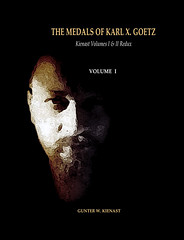
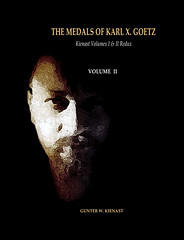
Hello Goetz collectors and enthusiasts!
The continued price increases for original hardbound Kienast Volumes I & II forced our decision to reprint this source material as a set. These reprints can serve to ‘even the playing field’ for potential collectors and others who could not find, and/or, afford copies of Kienast’s original books. Flying blind while trying to collect anything, especially Goetz material, is not a recommended practice. Reprint numbers of the set will be determined by actual demand.
These reprints are exact copies of Kienast’s original two volumes and as such do not contain any new information. For those of you requiring fresh information about Goetz medals, use these volumes as reference while visiting our web site at: www.karlgoetz.com. Although a work in progress, our galleries should provide any additional medal types, varieties, sizes, and metal compositions lacking, or not found, in these original books.
We wish to express our continued gratitude to G.W. Kienast for his generosity resulting in our ability to carry the story of Karl Goetz into the 21st Century.
Lastly, a generous portion of the revenue generated from these reprint sales will be contributed to the recurrent maintenance fees for the Goetz Family burial plot located in the Westfriedhof (West Cemetery), Munich, Germany.
Please order the two volume sets directly from the www.karlgoetzmedals web site. Make sure to follow the ordering instructions to ensure you receive free shipping within the contiguous 48 States.
To order, see: www.karlgoetzmedals.com/ProductDetail.aspx?ProductId=410
NEW BOOK: COMPLETE COINAGE OF SEPTIMUS SEVERUS
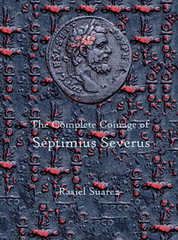 "The Complete Coinage of Septimius Severus", a new eBook by Rasiel Suarez aims to list and describe every known coin issued by this emperor. Each of over 1,400 listings includes mint dates, values and, in a first for ancient numismatics, precise rarity figures drawn from nearly 14,000 auction lots. Also included is a thorough high-resolution photography section to aid identification along with a brief biography and ancillary notes that will prove invaluable to any Severan specialist. Available now as a PDF eBook for $15 from dirtyoldcoins.com
"The Complete Coinage of Septimius Severus", a new eBook by Rasiel Suarez aims to list and describe every known coin issued by this emperor. Each of over 1,400 listings includes mint dates, values and, in a first for ancient numismatics, precise rarity figures drawn from nearly 14,000 auction lots. Also included is a thorough high-resolution photography section to aid identification along with a brief biography and ancillary notes that will prove invaluable to any Severan specialist. Available now as a PDF eBook for $15 from dirtyoldcoins.com
To order, see: The Complete Coinage of Septimius Severus (dirtyoldcoins.com/shop/Uncleaned-Roman-Coins.html)
NEW BOOK: MEDALLIC HISTORY OF THE WAR OF 1812
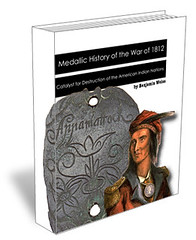 Medallic History of the War of 1812: Catalyst for Destruction of the American Indian Nations
Medallic History of the War of 1812: Catalyst for Destruction of the American Indian Nations
by: Benjamin Weiss
The European Americans promised Peace and Friendship with the Native American Nations by bestowing upon Indian Chiefs commemorative medals on which this promise was boldly proclaimed. Little came of man's words and shiny gifts as the battles fought between American and British forces during the War of 1812 led to the practical destruction of the Native American peoples.
Benjamin Weiss, avid collector of historical and commemorative medals, wrote his first eBook titled Medallic History of the War of 1812: Catalyst for Destruction of the American Indian Nations, the first publication in its kind to cover the subject of commemorative medals issued during the War of 1812 that concentrates on the role they and the war played in causing the near demise of the Native American Nations.
This eBook examines the War of 1812, using as a canvas historical and commemorative medals issued to the military commanders who fought so valiantly against the greatest naval power in the world. By fighting and driving the British from the newly-formed United States, the Americans accomplished their goal. They also succeeded in devastating the dreams of the Native American Nations, led by their great Shawnee leader Tecumseh. At the conclusion of the war, Tecumseh was dead and with him went the hopes and dreams of a confederated Indian Nation.
With historical medals serving as a backdrop, this ebook chronicles the causes and major battles fought between Americans and British during the War of 1812, a war which served as a catalyst for the virtual destruction of the Native American peoples.
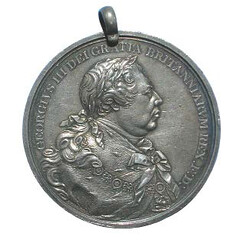
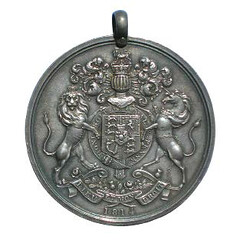
1814 George III Indian Peace medal
Richly illustrated, Medallic History of the War of 1812: Catalyst for Destruction of the American Indian Nations, is a must read for collectors of historical and commemorative medals. It should be of great appeal to those interested in American history, particularly in the little-known War of 1812 fought between the European Americans and the British and its enormous consequences to the American Indian Nations.
Published by the Kunstpedia Foundation, the eBook Medallic History of the War of 1812: Catalyst for Destruction of the American Indian Nations can be downloaded free and without any costs.
Summary: This eBook examines the War of 1812, using as a canvas historical and commemorative medals issued to the military commanders who fought so valiantly against the greatest naval power in the world. By fighting and driving the British from the newly-formed United States, the Americans accomplished their goal. They also succeeded in devastating the dreams of the Native American Nations, led by their great Shawnee leader Tecumseh. At the conclusion of the war, Tecumseh was dead and with him went the hopes and dreams of a confederated Indian Nation. With historical medals serving as a backdrop, this ebook chronicles the causes and major battles fought between Americans and British during the War of 1812, a war which served as a catalyst for the virtual destruction of the Native American peoples.

For more information, see: eBook Medallic History of the War of 1812: Catalyst for Destruction of the American Indian Nations (www.kunstpedia.com/ebook-medallic-history-of-the-war-of-1812-catalyst-for-destruction-of-the-american-indian-nations.html)
To download the 57-page ebook, see:
www.kunstpedia.com/PDFArticles/Medallic%20History
%20of%20the%20War%20of%201812.pdf
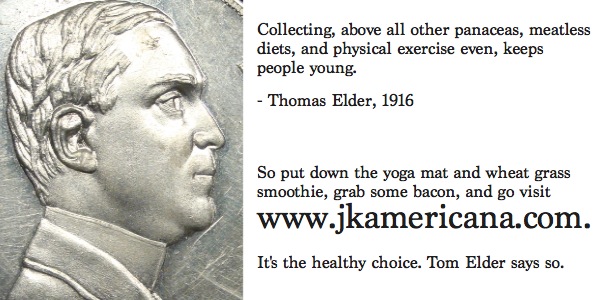
NEW BOOK: SYLLOGE NUMMORUM PARTHICORUM
 From time to time I am startled to see how much remains to be done in the field of numismatics despite the over 500 years of continuous research. One of the big desiderata was to catalogue and comment the Parthian coinage according to modern methods and thus improving much on Sellwood. A new project of the Austrian Academy of the Sciences (Österreichische Akademie der Wissenschaften) is to present the Parthian coinage in nine volumes. To achieve that goal 17,000 coins were gathered from the most important coin cabinets of the world, among which the National Museum of Iran. In 2012 Fabrizio Sinisi published the first volume of the Sylloge Nummorum Parthicorum (SNP) dedicated to the coinage from Vologases I to Pacorus II, i.e. the second half of the first century CE.
From time to time I am startled to see how much remains to be done in the field of numismatics despite the over 500 years of continuous research. One of the big desiderata was to catalogue and comment the Parthian coinage according to modern methods and thus improving much on Sellwood. A new project of the Austrian Academy of the Sciences (Österreichische Akademie der Wissenschaften) is to present the Parthian coinage in nine volumes. To achieve that goal 17,000 coins were gathered from the most important coin cabinets of the world, among which the National Museum of Iran. In 2012 Fabrizio Sinisi published the first volume of the Sylloge Nummorum Parthicorum (SNP) dedicated to the coinage from Vologases I to Pacorus II, i.e. the second half of the first century CE.
By the way, it is quite remarkable that the editors of the SNP – Michael Alram, Vesta Sarkhosh Curtis and Daryoosh Akbarzadeh – decided to publish in English. It is indeed a wise decision since English has become more and more the lingua franca of numismatics.
This book differs from the traditional principle of the Sylloge Nummorum Graecorum since it aims not only at presenting the material itself. Rather it pays equal attention to the contextualisation, the historical, numismatic and art historical interpretation. Therefore it starts with a historical overview comprising nearly 10 pages. A detailed interpretation of the images and legends follows. In some cases you must look very closely in order to distinguish the different bust types. The part focusing on the material concludes with a metrological study.
Then the author discusses the chronology of the types as defined in the previous chapters and their relation to the historical events. Those who regard this rather too complicated can consult the synchronogram that offers the types drawn in chronological order on six pages. Next, all types are listed in detailed manner and described precisely.
For more information on the series, see: Sylloge Nummorum Parthicorum (sylloge.org/Info/Home.aspx)
To order, see: Sylloge Nummorum Parthicorum: Vologases I - II Pacorus (verlag.oeaw.ac.at/Sylloge-Nummorum-Parthicorum-Vologases-I-Pacorus-II)
To read the complete article, see: A generations’ work: the Sylloge Nummorum Parthicorum (www.coinsweekly.com/en/News/4?&id=2275)
NEW BOOK: CAMBODIA COINS AND CURRENCY
 Cambodia Coins and Currency
Cambodia Coins and Currency
By Howard A. Daniel III
This reference is a comprehensive catalog of all known Cambodian financial instruments. It would not have been possible without the assistance of almost fifty contributors. Many of these contributors are not numismatists, but from several other fields. There were no Cambodian language references available going back to the 16th century, so much research was in the journals and reports of foreigners who visited or resided in Cambodia from the 16th century.
There are no known Cambodian financial instruments prior to the 16th century. Before that century, everyone used barter for their wants and needs, and all trade with foreigners was conducted by the ruling families and their highest officials. They bartered Cambodian goods for foreign products and bullion and base metal pieces. When bartering was an unequal trade for goods, foreign precious and base metal bullion pieces were used to complete the trade.
Many foreign traders, mostly Chinese, started settling in Cambodia, commercial transactions became common with ordinary Cambodians and coins were needed. The coins were very small but one small silver coin could purchase several chickens. As time went on, larger coins were created and circulated. After the country became a French protectorate and then a colony, French Cochin-Chine and Indo-Chine coins, and Banque de l’Indo-Chine bank notes circulated. After Cambodia regained its independence, it issued its own coins and bank notes, and many other financial instruments and related pieces.
During the French colonial era, tokens were minted for use within the royal palace grounds, and merchant tokens were minted which circulated in Phnom Penh. The French postal system also had postal money orders, reply coupons, stamp machine tokens, and telephone tokens. In modern times, the Cambodians issued their own postal financial instruments plus telephone cards. There were also stocks, bonds, foreign exchange certificates, casino tokens and chips, etc., etc. This catalog describes over 850 pieces from the 16th century to date.
There is a grading guide in the Introduction to assist collectors in matching the piece with its catalog value. The Introduction also defines many numismatic and related words and terms, and the Glossary has about fifty more words. There is also some historical and economic background information, to include numbers of pieces minted and printed. The research required almost fifty years of collecting the pieces, and reading over one hundred references and fifteen websites, all of which are identified in the Bibliography. There is also an Index to assist the reader in finding specific pieces within the catalog.
Since this catalog was published in December 2012, there has been an article published in Numismatique Asiatique, the journal of the Societie de Numismatique Asiatique, in which Joe Cribb reports the find of a 7th century Cambodian gold coin. I believe it is a presentation piece sent to the King Isanavarman possibly by the King of Dvaravati, or from another king as far away as India. Many kings sent gold and other objects to each other to celebrate an event, increase trade, make an alliance, etc. Gold was far too valuable to be a circulating coin at that time in Cambodia, and extensive research by archaeologist and historians has shown coins were not issued in Cambodia until the 16th century. I will correspond with Joe to discuss this piece.
To purchase a copy, contact me at:
Howard A. Daniel III
P.O. Box 626
Dunn Loring, VA 22027-0626 USA
Email: HADaniel3@msn.com
There are several different mailing charges and choices for customers but the basic retail price is US$25.
NEW BOOK: THE ENGLISH CIVIL WARS
Earlier this week I got a note from author Jerome Platt who wrote:
Please join us for the book launch party for The English Civil Wars: Medals, Commentary and Personalities. We look forward to seeing all our friends there, recognizing of course, that all you Yanks will only be able to attend in thought--however, should you decide to jump on a plane, that would be great!
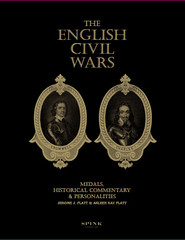 The English Civil Wars: Medals, Historical Commentary & Personalities
The English Civil Wars: Medals, Historical Commentary & Personalities
By Jerome J Platt & Arleen Kay Platt
Some three and a half centuries ago, Britain was convulsed by a series of civil wars which are still very much alive in the national consciousness. The names of its leaders, participants and major battles—Oliver Cromwell and Charles I, Cavaliers and Roundheads, Edgehill and Dunbar—are known to every Briton and many of the issues of that time still elicit strong reactions. These wars saw the introduction of medals as rewards for gallantry, campaign service and. This book, through the study of the events and personages for and by whom these medals were created, places them within the historical context of the times.
These volumes will be a welcome addition to the libraries of all who have an interest in the military rewards, personalities and events of the English Civil Wars. Building on earlier works on the subject, the present effort is a study of English Civil War medals in British museums or which have passed through major London auction houses as well as private collections. It provides detailed information which is indispensible for the collector, numismatist, auction house specialist and Civil War enthusiast as well as for the military or art historian with an interest in the period.
The detailed information on over 900 individual medals illustrating over 400 sub-types in both private and public collections, accompanied by more than 500 photographs and illustrations of medals, many in color, provides an important archival reference source. A comprehensive bibliography of the subject, including over 400 sources, will provide the reader with access to both antiquarian and contemporary scholarly references which were consulted.
Assembled from the first author’s findings and observations over thirty years of collecting and studying the medals of the period, this work places these ‘pieces of history’ within the historical context of the Civil War, the Interregnum and the Restoration, and brings alive those persons whose portraits are found on the medals as well as the events of the times. Through historical and biographical commentary on some 100 historical personages, the personalities of the figures of the period come into focus as human beings subject to many of the same views, feelings and motives, both selfless and base, as our contemporaries. Through the use of commentary and over 400 illustrations from the 17th through 19th centuries, we see the personages of the Civil War period as did both their contemporaries and those closer in time to the events of the English Civil War.
About the Authors:
Jerome J. Platt, Ph.D., before his retirement, was a medical school research director and the author of over a dozen books on drug addiction. Arleen Kay Platt, R.N. was a hospital nursing supervisor and manager of a research clinic for addicted adolescents. They are the authors, with Maurice E. Jones, of the well-received Whitewash Brigade: The Hong Kong Plague of 1894.
COLORADO FLOODS BYPASS E-SYLUM SERVERS
Susie Nulty writes:
Some areas are really hit hard by this rain. I live near Fort Carson in the southwest part of Colorado Springs. Fort Carson reports that it has received the normal annual rainfall in the last 3 days and it was still raining Friday afternoon. Many roads are a mess but I was out earlier this morning and could get around fairly easily. There are some monster puddles. So far, my home is fine although I go down to the basement every few hours to check - all dry and I am feeling very fortunate.
John Nebel writes:
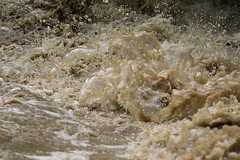 Along the Front Range, towns are often at the foot of canyons, as an example, Boulder with several. It doesn't take much rain above a town to cause a spectacular effect, as it's usually collected over an immense mountainous area, then accelerated by gravity and funneled below into a narrow canyon mouth.
Along the Front Range, towns are often at the foot of canyons, as an example, Boulder with several. It doesn't take much rain above a town to cause a spectacular effect, as it's usually collected over an immense mountainous area, then accelerated by gravity and funneled below into a narrow canyon mouth.
Below the canyon mouth, the water spreads out, slows down and isn't particularly dangerous to persons, but can be to property. Not too far above the water level, even in the worst places, watching is a sport, unintentionally in the water, certainly no sport.
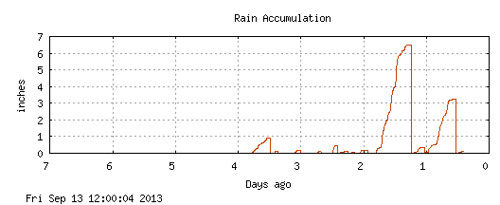
Wednesday rain was worse than Thursday, but both nights the Boulder creek flow rate was about 30 times normal. It will be a while before anyone really knows the extent of damage, which I think is now being exaggerated. Most people have only been inconvenienced, many not even that, which means that there is plenty of capacity to help those who really are in need.
I did spend time in the computer room both nights just in case, and many took some sort of precaution. If one lives in a canyon near a usually babbling brook, it's dangerous, and there is not a lot one can do, but move uphill, usually in the wet and cold, and at night.
But, it's a University town, and the atmosphere Friday was festive.
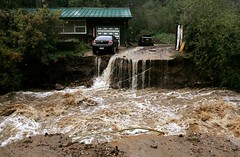 Four people have died in the floods, and the authorities said Friday that 80 people had been reported as unreachable or missing. With cellphone service down and the power out, some of the missing may simply be unable to communicate with friends or family.
Four people have died in the floods, and the authorities said Friday that 80 people had been reported as unreachable or missing. With cellphone service down and the power out, some of the missing may simply be unable to communicate with friends or family.
On Friday, thousands more Colorado residents were forced to evacuate their homes in the face of rivers and streams choked by heavy rains, dirt and debris.
In scenes that have become hauntingly familiar, families packed their cars with pets and suitcases and made their way to the nearest church or school that was offering shelter, left to wonder about the fate of their homes and neighbors. Some made it on their own, or in a neighbor’s car. Others fled on foot.
Up in the mountains, helicopters flown by the National Guard skimmed over ravaged roads to pluck scores of stranded residents from the flooded town of Jamestown.
To read the complete article, see: Colorado Floodwaters Force Thousands to Flee (www.nytimes.com/2013/09/14/us/colorado-flooding.html)
Thoroughly eccentric; a Boulder creek flood stranded crayfish in the Justice Center parking lot. It immediately brought to mind the Katane tetradrachm.
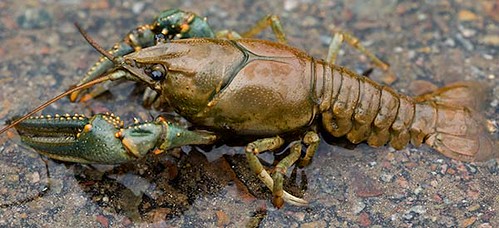

Rare U.S. & Worldwide Banknotes, Scripophily and Autographs
“The Copps Collection” of Colonial Stocks, Bonds, Documents & Fiscal Paper to be held in conjunction with the 3rd Annual Wall Street Coin, Currency & Collectibles Show.
Highlights include:
- From “The Copps Collection”, A 1792 U.S. Federal Bond Issued to and Signed by George Washington, this is one of three known, the other two are in an institutions, this is the first time ever at auction
- U.S. Colonial; Obsolete; Fractional; and, Large Type Notes including a high grade “Educational” Set of 3 notes along with dozens of other rare banknotes.
- Worldwide Banknotes including an outstanding U.A.E. Specimen Set as well as hundreds of other rare and desirable notes.
- Hundreds of U.S. & Worldwide Stocks and bonds including autographed certificates and autographs by Daniel Drew; Thomas Edison; Buffalo Bill Cody, Robert Morris and many others.

1580 Lemoine Avenue, Suite #7
Fort Lee, NJ 07024
Phone: 201-944-4800
Email: info@archivesinternational.com
WWW.ARCHIVESINTERNATIONAL.COM
READERS REMEMBER ERIC VON KLINGER

Fred Lake writes:
Eric Von Klinger was a friend and consignor to a number of Lake Books numismatic literature sales. He was a very knowledgeable guy and always eager to share those tidbits whenever we met. He will be sorely missed in the numismatic community.
Harold Levi writes:
It is with great sorrow that I read of Eric von Klinger’s passing. I wondered why he had not answered my last e-mail. He had told me of his cancer and at that time was not sure if the treatments had put it into remission.
I have great memories of the 2004 ANA convention in Pittsburgh. This was when I met E-Sylum Editor Wayne Homren and Eric. We spent some time discussing attributes I needed to include in my forthcoming book on the Confederate cent, among other topics. I found that both Eric and I hated footnotes but disliked endnotes even more, the book has footnotes.
Earlier that day, George Corell and myself had given our Confederate cent presentation. As part of this, we introduced Katie (Yeager) DeSilva to the numismatic community. For those who may not know, Katie is a great-great granddaughter of George H. Lovett, who was Robert Lovett, Jr.’s brother. Beth Deisher, had assigned Eric to cover our presentation and interview Katie. Eric got his interview and liked the work that George and I were doing on Confederate coinage.
Rest in Peace my good friend!
Bob Van Ryzin writes:
My wife, Sharon, and I are saddened to learn of Eric's death. He was a good friend and a former co-worker of mine at Krause Publications.
He was very knowledgeable about coins, which you could tell just by a short conversation with him. He was also passionate about the hobby and about writing.
I hadn't seen him since an ANA a number of years ago, but I often corresponded with him by email, in which he would always end his replies, no matter how bleak the news, with a hopeful, "Cheers, Eric."
To read the earlier E-Sylum article, see: ERIC VON KLINGER, 1946 - 2013 (www.coinbooks.org/esylum_v16n37a08.html)
MORE ON 'NUMISMATIC TIMES AND TRENDS'
Peter Mosiondz, Jr. writes:
In answer to Dave Lange’s query concerning Numismatic Times and Trends it was started to compete the other numismatic newspapers of the day. I believe it ran until sometime in late 1961 or perhaps into 1962. I was one of their charter subscribers and have been looking for copies without success for some years now. Classified ads were either very inexpensive or free to subscribers; I can’t remember which. Many early ads of mine were contained in that back section. I seem to recall that NT&T focused on coin values. I’ll be looking forward to what others remember.
Dan Hamelberg writes:
I have 7 issues starting with Vol. I, #I (1-10-61), Vol. I, #2 (1-25-61), Vol I, #3 (2-10-61), Vol I, #4 (2-25-61), Vol. I, #5 (3-10-61), Vol. I, #6 (3-25-61), and Vol. I, #9 (5-10-61). The issues feature a classified ad format along with market prices for rolls, mint and proof sets, etc. The March, 25, 1961 issue has an interesting cover story on the Kosoff auction of the Edwin Hydeman collection. The sale featured a 1913 Liberty Nickel which reached a high bid of $41,000, but did not sell as it did not hit the reserve of $50,000.
Mike Paradis forwarded the following from Kolbe's sale 103 (June 7, 2007):
255 NUMISMATIC TIMES AND TRENDS. VOLUME I, NUMBER 1 – VOLUME I, NUMBER 22. New Orleans, January 10 November 25, 1961. 658 pages, illustrated. (bound with) COINS MAGAZINE. VOL. IX, NO. 1. Iola, January 1962. 46, (2) pages, illustrated. Quarto. Black cloth, gilt. Fine. (100.00)
Ex John M.Willem. All issued of the main publication. A printed notice stapled to the issue of Coins Magazine reads in part: "Announcing The Sale of Numismatic Times and Trends to Chester L. Krause, Publisher of Numismatic News and COINS magazine. Times and Trends suspended publication in December. The subscription obligation is being met by COINS magazine, formerly Coin Press Magazine. Starting with the October 25 issue, Clement F. Bailey came on board as Associate Editor, remaining in that position for the last three numbers. The only complete set we recall ever having encountered of this interesting and informative publication, similar in content to Coin World.
Clifford Mishler writes:
 I believe I can provide a fairly definitive response to Dave Lange’s inquiry concerning the publishing of “Numismatic Times and Trends” out of New Orleans back in 1961. It happens that I did subscribe to the publication, and somewhere in my unorganized archive there are certainly some copies lurking, if not all of the issues published, but I am presently at a loss as to where I might put my hands on them.
I believe I can provide a fairly definitive response to Dave Lange’s inquiry concerning the publishing of “Numismatic Times and Trends” out of New Orleans back in 1961. It happens that I did subscribe to the publication, and somewhere in my unorganized archive there are certainly some copies lurking, if not all of the issues published, but I am presently at a loss as to where I might put my hands on them.
The only issues published were dated in 1961, from January 10 through November 25, the publication appearing twice monthly dated on the 10th and 25th. It can be found listed in Remy Bourne’s two volume compilation “American Numismatic Periodicals” published in 1990, with a claimed circulation of 12,400 as of the second issue dated January 25. The founding publisher was William J. Gruber and the editor Kenneth F. Pierce, two of a team of active New Orleans area collectors and dealers who were initially involved with the publication.
It was announced in the January 1, 1962, edition of “Numismatic News” that the publication had been acquired by Chester L. Krause on December 12, 1961, who in the fall of 1961 had acquired “Coin Press” magazine from Frank G. Spadone, which had been re-flagged as “Coins” magazine effective with the January 1962 dated edition. The subscription obligation of NT&T was assumed by “Coins,” with the announcement indicating the combined “circulation of the two Krause publications (Coins and Numismatic News) now total double that of all existing numismatic publications.”
In discussing the acquisition with Chet, as this was before I moved to Iola and joined the staff (March 1963), his best recollection is that “Numismatic Times and Trends” was “acquired for a modest financial consideration and assumption of the outstanding subscription obligation.” In addition to assumption of the subscription obligation, some of the publication’s features and contributors were migrated to “Coins” and “Numismatic News.” The “Times” staff and engaged correspondents at the time numbered nine.
When Krause acquired the title, sole ownership was in the hands of Kenneth Pierce. Another of the early owners was Frank Gruber, who held forth at a promotional table during the 1961 FUN convention in Miami at the time the product was being launched. A photo recap page published in the January 1, 1962, edition of the “News” included a picture of Gruber and his wife were pictured at the table.
One interesting point that Dave made reference to concerns a statement, made in a release published on the front page of the first edition of the “Times,” that successive “pilot issues” were distributed to “some of the foremost authorities” in the field prior to the launch of publication. Bourne did not document the existence of the referenced “pilot” offerings, and I have never seen a copy of one. Perhaps someone out there can fill in that detail for us.
To read the earlier E-Sylum article, see: QUERY: 'NUMISMATIC TIMES AND TRENDS' INFORMATION SOUGHT (www.coinbooks.org/esylum_v16n37a22.html)
NOTES FROM E-SYLUM READERS: SEPTEMBER 15, 2013
National Coin Album Books Forthcoming
Dave Lange writes:
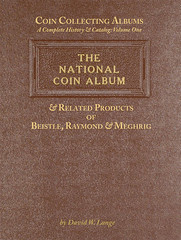 I just heard from my printer that the National Coin Album books will be in my hands on or around October 14. I'm disappointed that I won't have them for the Philadelphia and Long Beach shows, but I will have my own printout of the book at the NGC booth for both shows, and I'll be taking pre-orders at the discounted price of $65.
I just heard from my printer that the National Coin Album books will be in my hands on or around October 14. I'm disappointed that I won't have them for the Philadelphia and Long Beach shows, but I will have my own printout of the book at the NGC booth for both shows, and I'll be taking pre-orders at the discounted price of $65.
For more information on Dave's upcoming book, see: NEW BOOK: COIN COLLECTING ALBUMS, VOLUME ONE (www.coinbooks.org/esylum_v16n32a02.html)
The Staying Power of Yap Stone Money
Rudy Valentin writes:
Around the early 1960's, while serving in the U.S. Coast Guard in the Pacific area, I had the opportunity to visit the Island of Yap on various occasions. I became friendly with the natives and asked them about their stone money system and their rationale behind it. They told me; "The Germans came with their marks and left, The British came with their pounds and left, The Spaniards came with their reales and left, The Japanese brought their yens and are gone. Now the Americans have brought the dollars, and we don't know how long they are going to be here. But all the time, our stone money is still here."
The main principle of the stone money is similar to the Gold Standard. As long as we have lots of it buried in Fort Knox, our paper money has value. This is why the U.S. exchanged the Puerto Rico peso at .60 cents to the dollar when we took over that island as a result of the Spanish/American war in 1898, notwithstanding the fact that the P.R. peso had slightly more silver than the U.S. silver dollar.
Nevertheless, the Puerto Rican peso in today's market is worth from $300.00 to $10,000.00, depending on the condition. What goes out, comes back!
To read the earlier E-Sylum article, see: MORE ON JOHN MAYNARD KEYNES AND YAP STONE MONEY (www.coinbooks.org/esylum_v16n37a18.html)
Another Wedgwood portrait of the Vicomte de Noailles
Richard Margolis writes:
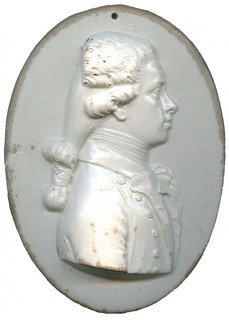 I have an identical Wedgwood portrait of the Vicomte de Noailles in my collection, acquired at a London auction sale six years ago.
I have an identical Wedgwood portrait of the Vicomte de Noailles in my collection, acquired at a London auction sale six years ago.
Both the Baldwin's example and mine are correctly described as creamware factory reference models, as they were hung up and used as guides for Wedgwood's factory workers (hence the piercing, which occurs on all of the factory reference models I have seen).
These reference models (although not the Noailles), frequently feature a sometimes amusing phonetic rendering of the subject's name inscribed on the back. For example, the Warren Hastings Wedgwood reference model in my collection is identified as A.Stain .
To read the earlier E-Sylum article, see: BALDWIN'S 83RD SALE TO BE HELD SEPTEMBER 24, 2013 (www.coinbooks.org/esylum_v16n37a31.html)
More on the Term Nova Eborac
Last week's Featured Web Site was about the Nova Eborac tokens, with "Nova Eborac being the Latin for New York".
Arthur Shippee forwarded this article, noting:
Eborac is an abbreviation -- as noted with the "." following EBORAC. No Latin word would end in "c".
Eboracum is the Roman name for York, but just how did we get from Eboracum to York?
The answer involves boars, mistranslation and the oddities of the Nordic tongue!
One aspect of the Roman legacy which is not as obvious is the city's name, York. Eboracum, the Roman name for York, sounds exotic and Latinised to our ears, and on initial consideration, appears to have little in common with the city's modern-day name. But in fact, the name York is a direct descendent of the name Eboracum.
The Legio IX Hispana believed the name meant 'place of the boar'. Subsequently the boar appears on numerous inscriptions as a symbol of York.
Following the Romans' departure in c400AD, the Anglo-Saxon invaders substituted Eboracum for their own word for boar and town, Evorwic. However, the next set of invaders, the Vikings, couldn't quite get their tongue round Evorwic, so they settled for Jorvik. Pronounced 'Yorvik' the step to York is hardly surprising.
To read the complete article, see: What the Eboracum's it all about? (www.bbc.co.uk/northyorkshire/iloveny/romans/2004/eboracum_name/index.shtml)
To read the earlier E-Sylum article, see: FEATURED WEB PAGE: NOVA EBORAC COPPERS (www.coinbooks.org/esylum_v16n37a32.html)
MORE ON CREATESPACE AND AMAZON PRICING
Frederick Liberatore writes:
I cannot thank you enough for publishing Paul Torongo's comments concerning his problems getting his superb book Collecting Medieval Coins: A Beginner's Guide, especially the pricing horror story. I had ordered the book for $47.50 from Amazon and on discovering it was being sold DAYS later for about $18 was outraged and let Amazon know. I received the response below. I am hoping you can alert other purchasers about this possibility of a rebate from Amazon for overcharging.
Thanks for contacting us about the recent price change on "Collecting Medieval Coins: A Beginner's Guide". I recognize you have a choice of retailers and appreciate that you prefer to order from us.
I've reviewed your order and see that your items have already been delivered.
Since the price of the item has changed within seven days of the delivery of the order, I've issued a refund for the price difference in the amount of $31.64 to your Master Card.
You'll see the refund on your Master Card statement in the next 2-3 business days.
Jon Radel writes:
I ordered a 2nd copy and am returning the more expensive copy. Since I don't pay for shipping to me, this will cost me only the return shipping. Almost as good. :-)
Ginger Rapsus writes:
I published 6 novels with BookBaby, and am satisfied with the results (although I would like to get royalty statements in a more timely manner). I do not know how it would be if I published a non-fiction coin book with photos.
Greg Burns writes:
I, too, have a book produced by Createspace, and intrigued by the pricing anomaly described by Paul went and ordered his book (a steal at the $16 offering). Within hours it was reported as shipped, and it arrived the next day, less than 24 hours after ordering.
One of the end pages of the book is marked “Made in the USA / San Bernardino, CA / 08 September 2013”. Amazing - ordered, printed, mailed, and received in less than 24 hours…
To read the earlier E-Sylum article, see: AN AUTHOR'S EXPERIENCE: CREATESPACE AND AMAZON.COM (www.coinbooks.org/esylum_v16n37a10.html)
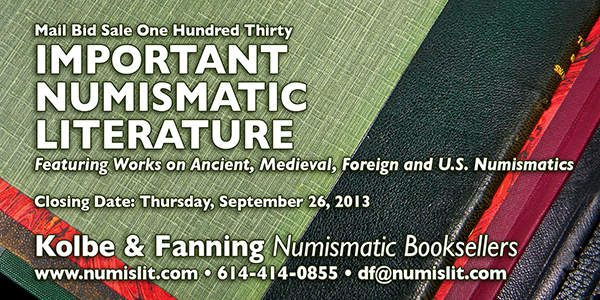
WEB SITES FOR OLD MAGAZINES
David Ganz writes:
The New York Times site has issues from 1854 to date (subscription), but members of the Bergen County Cooperative Library System (BUCKLES) have free access.
Ron Ward writes:
The reference Fred is seeking is: "Readers' Guide to Periodical Literature", H.W. Wilson Co., which has been published since the early 1900s. It covers articles from about 400 popular magazines which are listed by author and subject matter. It is published monthly and the issues are combined into a yearly volume.
In Montgomery Co., MD, a complete set is available at the Montgomery Co. Regional Library in Rockville. I do not think an on-line version is available. Subscriptions are about $500.00 a year. There are other guides such as Index Medicus, Biological Abstracts, Chemical Abstracts, but I think these would be of little use. I do remember that Index Medicus had a section on Medical Numismatics.
Dave Ginsburg writes:
As long as "Old Magazines" means 19th century publications, I've found that Google has digitized bound volumes of publications such as Hunt's Merchants Magazine and many others (although given Google Books' "clunky" search mechanism, I usually have an easier time finding the available bound volumes at HathiTrust.
I also like to use the Making of America sections of the Cornell University and the University of Michigan library websites. They have such magazines as Harper's Monthly and The Democratic Review (Cornell) and DeBow's and Southern Quarterly Reviews (U of Michigan).
The last time I checked, several years ago, Harper's Weekly was still only available via CD, which was available for purchase.
Making of America - Cornell
They have Harper's Monthly from June 1850 to May 1899.)
http://ebooks.library.cornell.edu/m/moa/browse.html
Making of America - University of Michigan
quod.lib.umich.edu/m/moajrnl/browse.journals/
Hunt's Merchants' Magazine at HathiTrust
Click on "Catalog Record" to find additional volumes. Sometimes the quality of the scan varies by university source and some sources have different volumes; one should check all source universities, if necessary.
babel.hathitrust.org/cgi/ls?field1=ocr;q1=hunt%27s%20merchants%27%20magazine;a=srchls;lmt=ft
Niles' Weekly Register at HathiTrust
(same advice as above)
babel.hathitrust.org/cgi/ls?field1=ocr;q1=Niles%27%20weekly%20register;a=srchls;lmt=ft
I'm sure that HathiTrust has a lot more periodicals than I've ever looked for. Finding them is sometimes a chore: for example, searching on "Niles' Register" didn't return the results that "Niles' Weekly Register" did. (I suppose it's barely possible that I'm as poor an Internet searcher as my wife, a trained researcher, claims.) Also, it's easy to download a .pdf file of an entire volume from Google Books, while one can only download .pdf files of individual pages from HathiTrust (and only 20 pages or so at a time).
By the way, the current Harper's Magazine website ( http://harpers.org/) has all archives for Harper's Monthly going back to June 1850, which is available to current Harper's subscribers. I looked very briefly, but didn't find a good source for Harper's Weekly.
To read the earlier E-Sylum article, see: QUERY: ARE THERE ANY SEARCH SITES FOR OLD MAGAZINES? (www.coinbooks.org/esylum_v16n37a23.html)
16TH STREET BAPTIST CHURCH BOMBING VICTIMS MEDAL
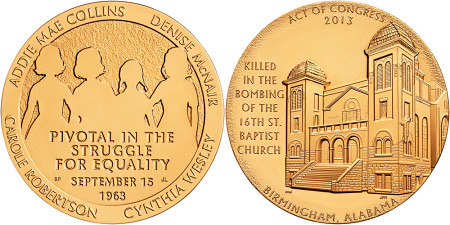
At a ceremony held yesterday at the U.S. Capitol Building, a Congressional Gold Medal was awarded posthumously to Addie Mae Collins, Denise McNair, Carole Robertson, and Cynthia Wesley. These four young black girls lost their lives in the bombing of the 16th Street Baptist Church in Birmingham, Alabama on September 15, 1963. The bombing and death of the four girls served as a catalyst for the civil rights movement and contributed to support for the passage of the Civil Rights Act of 1964.
The Congressional Gold Medal was authorized under Public Law 113-11, which provided only broad guidance on the design for the medal. The medal was to be “of appropriate design to commemorate the lives of Addie Mae Collins, Denise McNair, Carole Robertson, and Cynthia Wesley” and contain “suitable emblems, devices, and inscriptions.” The final designs were selected by the Treasury of the Secretary in consultation with the Birmingham Civil Rights Institute, the Commission of Fine Arts, and the Citizens Coinage Advisory Committee.
The obverse design features a silhouette of the four girls, with inscriptions of their names around the outer border of the design. Additional inscriptions “Pivotal in the Struggle for Equality” and “September 13 1963″ appear incused across the silhouettes. The obverse was designed by Barbara Fox an engraved by Jim Licaretz. The reverse depicts a view of the 16th Street Baptist Church. The inscriptions include “Act of Congress 2013″ above, “Killed in the Bombing of the 16th St. Baptist Church” to the left, and “Birmingham, Alabama” beneath. The reverse was designed by Donna Weaver and engraved by Joseph Menna.
The United States Mint will offer bronze reproductions of the Congressional Gold Medal. The 3-inch bronze medal is priced at $39.95 and the 1.5-inch bronze medal is priced at $6.95. These will go on sale today, September 11, 2013 at 12:00 Noon ET.
To read the complete article, see: 16th Street Baptist Church Bombing Victims Bronze Medal (mintnewsblog.com/2013/09/16th-street-baptist-church-bombing-victims-bronze-medal/)
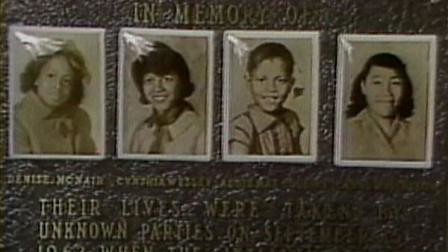
House and Senate leaders on Tuesday awarded Congress' highest civilian honor to four girls killed in the Alabama church bombing nearly 50 years ago that became a watershed moment in the civil rights movement.
The Congressional Gold Medal went to Addie Mae Collins, Carole Robertson and Cynthia Wesley, who were all 14, and Denise McNair, who was 11. The ceremony came five days before the 50th anniversary of their deaths inside the 16th Street Baptist Church in Birmingham.
"Their names remain seared in our hearts," said House Democratic leader Nancy Pelosi of California. She was joined at the commemoration by Senate GOP leader Mitch McConnell of Kentucky, Senate Democratic leader Harry Reid of Nevada, House Speaker John Boehner, R-Ohio, and members of Alabama's congressional delegation.
Along with the many lawmakers in the crowd paying tribute were director Spike Lee, and several relatives of the girls.
The girls were killed in the explosion of a bomb planted outside the church by white supremacists. The attack shocked the nation and helped spur passage of the Civil Rights Act of 1964 and the Voting Rights Act of 1965. Three Ku Klux Klan members were convicted of the bombing years after the attack and sentenced to prison. Two have since died; one remains in prison.
To read the complete article, see: Congressional Gold Medal awarded to Birmingham church bombing victims (abclocal.go.com/wls/story?section=news/national_world&id=9243650)
THE BOOK BAZARRE
ELDER SOLD LARGE-PAPER VERSION OF ATTINELLI’S NUMISGRAPHICS
Sometimes this writer gets schooled. Such a schooling just happened after last month’s column discussing the mysterious disappearance of all large paper copies of Numisgraphics, Emmanuel Joseph Attinelli’s indispensable bibliography of numismatic auction catalogs.
I correctly wrote that 10 large, paper copies of Numisgraphics were produced in 1876. I also correctly wrote that Attinelli still had four large, paper copies left to sell in 1878 when he cataloged the C.W. Idell sale.
But then I incorrectly wrote that all 10 copies had vanished immediately afterwards. It was John W. Adams who proved me wrong. And there is no better teacher to give you a schooling about numismatic literature.
So what did he know that I didn’t? Not all large, paper copies disappeared from the face of the earth after the Idell sale in 1878, for Adams discovered that, at the height of the Great Depression, coin dealer Thomas Elder sold one.
In Elder’s 242nd Sale (April 1, 1932), Adams discovered lot 1302 offered a copy of Numisgraphics, with a brief, but significant description: “Quarto—Pages Loose.”
All of the regular issue copies of Numisgraphics are octavo in size while a quarto book is considerably larger; about the same height and depth as an encyclopedia volume (and about the same size as the “royal octavo” that Attinelli described in the Idell sale).
So Elder was selling one of those 10 large paper copies. The notation that the pages were loose probably meant that they were unbound. Adams’ find proves that at least one of the large paper copies of Numisgraphics survived 54 years after the Idell auction.
But the great mystery remains: Where are these large paper copies today? How could every example vanish? And who will be the first collector to make headlines by unearthing one?
To read the complete article, see: Schooled by the best (www.coinworld.com/articles/viewarticle/schooled-by-the-best)
HUB AND DIE MAKING AT THE PHILADELPHIA MINT
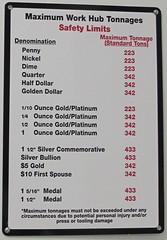 My brother and I were treated to a special tour of the operations at the United States Mint facility in Philadelphia. We had planned this trip for some time so I had many preconceived ideas of what would be most exciting.
My brother and I were treated to a special tour of the operations at the United States Mint facility in Philadelphia. We had planned this trip for some time so I had many preconceived ideas of what would be most exciting.
I’ll be the first to admit, the procedures related to hub and die making were not high on my list. Our father was a tool-maker so I expected this process would be familiar and, as such, not heart-pounding.
Much to my surprise, I was completely enthralled. It was not the mechanics of it all that was most inspiring. It was the people. Sure, the equipment is impressive. Yet more striking, those in the hub and die making area projected great pride in their work and that really forged a lasting memory for me. Actually, we found high levels of pride and dedication all around the place. But as I had not expected too much from this particular section, their drive turned it into a great time for me.
Everything starts from steel. Bars of the metal arrive at the Philadelphia Mint in 10-12 foot lengths, which are then cut into 42-inch lengths and stored until needed.
A Mikron CNC milling machine is used to cut hubs and dies. If it looks familiar, that’s because it’s the same machine that is used to create Resin templates for U.S. Mint artists who sculpt in clay. It generally takes 15-20 hours to cut a coin hub and 25-30 hours to cut a 3-inch die. These CNC machines are more efficient and can produce a better quality product than the retired Janvier Transfer Engraving Machines.
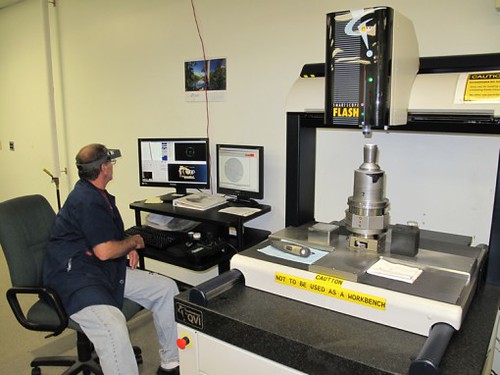
To read the complete article, see: How the Philadelphia Mint Makes Hubs and Dies to Produce Coins (www.coinnews.net/2013/09/13/how-the-philadelphia-mint-makes-hubs-and-dies-to-produce-coins/)
SCHULER GROUP: COIN PRESS MAKER TO THE WORLD
 Did you know that Germany is number one with regard to coin minting? No, it’s not because Germany has so many more Mints than most other countries but because almost every Mint actually uses German technology. Many small as well as big highly-specialized companies produce the machines necessary to manufacture coins. One of the major ‘global players’ is the Schuler Group with headquarters located in Göppingen, and not just since yesterday.
Did you know that Germany is number one with regard to coin minting? No, it’s not because Germany has so many more Mints than most other countries but because almost every Mint actually uses German technology. Many small as well as big highly-specialized companies produce the machines necessary to manufacture coins. One of the major ‘global players’ is the Schuler Group with headquarters located in Göppingen, and not just since yesterday.
When Gustav Buschick and Theodor Choulant visited the machine works of Louis Schuler in Göppingen in April 1905, they saw as many as 30 minting machines to be delivered to China.
At that time, Schuler was an established company already. It had been founded by Louis Schuler (1814-1890) in 1839. He visited the famous Great Exhibition, the very first World’s Fair, in London in 1851. There he could see how metal was processed, i.e. not time-consumingly by hand, but with the aid of huge presses. Schuler wanted to do the same in Germany, and thus started to construct machine tools for sheet metal processing in 1852. Since around 1870, Schuler has likewise been producing minting machines. That, however, constituted only a small part of the business.
Horizontal Coin Minting
Many of the things hidden once the machine is closed can be seen in their rough state, like the blankfeeding for the horizontal coin minting. The blank is placed almost vertically between the punches which are positioned not above and below, but on the right and the left-hand side. The decisive factor is that, thanks to its weight and earth’s gravitational pull, the blank drops quickly to the actual minting place in a way that couldn’t be achieved by the vertical procedure where it must be pushed in the right direction mechanically. This principle allowed the coin output to increase significantly.
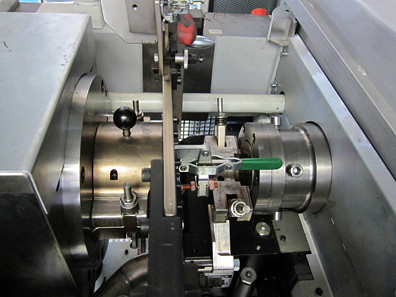
Horizontal coin minting
To read the complete article, see: Coin minting presses for the entire world (coinsweekly.com/en/page/4?&id=2257)

LOTS FROM THE KOLBE-FANNING SALE #130: FISHER, MEHL'S MONTHLY
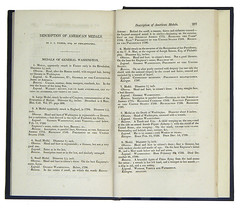

Lot 459: Fisher's Description of American Medals
Fisher, J. Francis. DESCRIPTION OF AMERICAN MEDALS. Collections of the Massachusetts Historical Society. Third Series, Vol. VI. Boston: American Stationers’ Company, 1837. 8vo, later blue cloth, gilt. (4), 300 pages. [Fisher’s article comprises pages 286 to 293.] Old library stamp; some light discoloration to extremities. Near fine. (2250.00)
One of the landmarks of early U.S. numismatic literature, Joshua Francis Fisher’s work is only the second article published in the United States discussing coins or medals from the point of view of a numismatist. While a number of publications predate this and James Mease’s 1821 “Description of Some of the Medals Struck in Relation to Important Events in North America” (generally regarded as the first truly numismatic article published in this country), those early publications were written for merchants, bankers, lawyers, politicians and other people who dealt with monetary issues on a daily basis. Works had not been written from the point of view of one who studies coins and medals.
Both Fisher’s and Mease’s articles are extremely rare. The article itself is far from being a rehashing of Mease’s previous work: in fact, they list only one medal in common: the “Washington before Boston” medal of the Comitia Americana series. Fisher describes 14 Washington medals, 5 Franklin medals, one each depicting Jefferson and Benjamin Rush, 3 medals of the Revolution and 14 earlier colonial medals including the very rare Lord and Lady Baltimore medal. Fisher’s article is more concerned with colonial-era medals than Mease’s, which mostly describes the Comitia Americana series and related medals. Attinelli 111.
Lot 516: Mehl's Numismatic Monthly
Mehl, B. Max [publisher]. MEHL’S NUMISMATIC MONTHLY. Vols. I–X (1910–19). Fort Worth: B. Max Mehl. Ten volumes, complete. 8vo, original printed card covers; Vol. IV neatly bound in brown cloth, gilt. 1756 pages; numerous halftone text illustrations of coins; portraits of famous American and Canadian numismatists, etc. Some duplicates included. Occasional signs of wear; overall very good to fine. (1500.00)
An underrated source of information, Mehl’s Numismatic Monthly is especially rich with word sketches of turn of the century American numismatists, often accompanied by individual or group photographs. Also featured are short monographs on many unusual numismatic topics, including a wealth of data on Canadian numismatics.
Of Mehl and his Monthly, John Adams wrote: “The career of B. Max Mehl was an impossibility. He had at least three strikes against him: 1) he was an immigrant Jew in a then-gentile hobby; 2) he was located in Fort Worth, Texas, at a time when 95 percent of the business was done on the East Coast; and 3) Lilliputian in stature and colorless in terms of personality, he adopted a business plan that relied on creativity and promotion. Quite obviously, Mehl did not realize that he was licked before he started. He just knew that it was a lot more fun to sell coins than to sell shoes. From there, he took it one step at a time … in the formative years, what probably made the difference was Mehl’s Numismatic Monthly. Launched in January of 1908, the early volumes of the Monthly are easily the equal of The Numismatist, boasting original articles by such gifted writers as R.W. McLachlan, Edgar Adams, Howland Wood, George Blake, Dr. Eugene Courteau, J.W. Haseltine and Frank Stewart.”
For more information about the sale, see: www.numislit.com
MEDALS STRUCK WITH CANCELLED 1995 OLYMPIC DOLLAR DIE
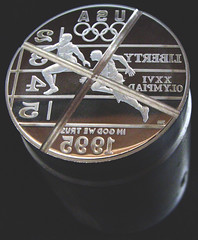
3 Commemorative medals struck from a cancelled 1995-P Atlanta Olympics Track & Field Commemorative Dollar die. The reverse is a unique reverse that reads, Around: "ONE OF 100 PIECES STRUCK ON / CANCELLED U.S. MINT DOLLAR DIE". Center: "1996 Atlanta Centennial Games / Engraved Number / .999 FINE SILVER". 100 Sets of: One Troy Ounce .999 Fine Silver; Bimetallic medal of 1/2 Troy Ounce .999 Fine Silver in Copper Ring; Bimetallic medal of 1/2 Troy Ounce .999 Fine Silver in Brass Ring. Each set comes with three Certificates of Authenticity for each medal. Medals and Cards numbered from 001 to 100. Most set numbers available - submit request of choices and we will do our best to get you one of them.
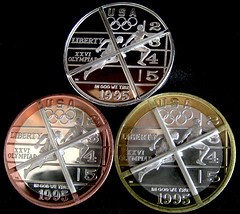

To view the eBay lot, see: Atlanta Olympic Track & Field Dollar - Medals Struck from Cancel Die 100 Sets (www.ebay.com/itm/ws/eBayISAPI.dll?ViewItem&item=321206225307)
THE BOOK BAZARRE
MORE ON THE ERIC THE RED LIFESAVING MEDAL
Darren Burgess writes:
Following on from your request on the Eric the Red Lifesaving Medal on display in Warrnambool in Vol 16, No. 28, Article 27 regarding better pictures and more information on the medal I've finally had the chance to pop down to the Flagstaff Museum yesterday (it's a 4 hour drive from Melbourne, but worth it) and they told me the story of the acquisition (a donation from a relative of one of the crew of the SS Dawn) showed me some stunning digital photos (the medal is currently in a safe, but will go on display soon) and informed me that they've uploaded more information and photos of the medal on to the Collections Victoria Website. The museum were keen to get more information on other medals of this type and a possible valuation.
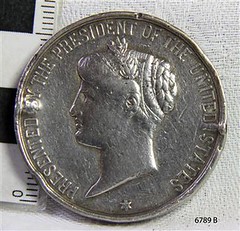
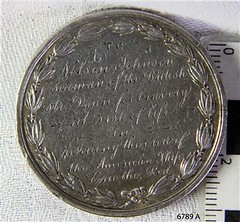
“TO / Nelson Johnson, / seaman of the British, / str “Dawn”, for bravery, / at risk of life, / in / rescuing the crew of / the American Ship / “Eric the Red.”
“M” on obverse, truncation of the portrait
Size Historical Information
The medal is engraved with the name “Nelson Johnson” (the anglicised version of his Swedish name Neils Frederick Yohnson). It was donated to Flagstaff Hill Maritime Village in 2013 by Nelson’s granddaughter. Nelson had migrated from Sweden to Sydney in 1879. The next year in 1880, aged 24, he was a seaman on the steamship Dawn and involved in the rescue of the survivors of the Eric the Red.
The medal’s history, according to the Editor of ‘E-Sylum’ (the newsletter of the The Numismatic Bibliomania Society “… appears to be an example of an 1880 State Department medal, catalogued as LS-3 (page 322 of R. W. Julian's book, Medals of the United States Mint: The First Century 1792-1892). The reverse is mostly blank for engraving, surrounded with a thin wreath. It was designed by George Morgan, chief engraver for the Philadelphia Mint, and struck in gold, silver and bronze. The one pictured here (in The Standard newspaper, 2nd July 2013) appears to be silver.”
To read the complete description on the Collections Victoria Website, see:
Medal for bravery, Eric the Red rescue
(victoriancollections.net.au/items/51fb233c2162ef156c79e272)
To read the earlier E-Sylum article, see:
ERIC THE RED LIFESAVING MEDAL ON DISPLAY IN WARRNAMBOOL
(www.coinbooks.org/esylum_v16n28a27.html)
The Pejepscot Historical Society (PHS) has just announced that it has added Joshua Chamberlain’s Medal of Honor to its collection. It is quite appropriate for PHS to be the custodian of this priceless item, since it runs the Joshua L. Chamberlain Museum which is housed in the building where General Chamberlain and his family lived from 1856 until his death in 1914.
How the anonymous donor (AD) came on the medal is a great New England story. According to this story in the Times Record, Chamberlain’s last living descendant, his granddaughter Rosamond Allen, left her estate to First Parish Church of Duxbury when she died in 2000 at the age of 102. The church held a book sale. Having been to many a church book sale, I am trying to picture it in my mind. Was it a few piles of books on tables going for a couple of bucks ? I dabble in books a bit and am well aware most books, even if quite old, are not worth very much, but there will often be the odd unrecognized treasure in the pile.
Taking it home, the donor finds the medal in there. It was a generous act to then give it to just the right organization anonymously in honor of all veterans. It might be good to leave the story there, but I’m a tax geek and I can’t help but wonder if the donor is entitled to a charitable contribution and, even more interesting, how much that contribution might be.
A Minor Flaw In The Chain Of Custody
A Medal of Honor is the personal property of the recipient and the recipient can do as he pleases with it, except that it is illegal for the recipient or anybody else to sell the medal. I’m wondering if this casts just a little doubt on the ownership. First Parish of Duxury sold a book which happened to have the medal in it. The Church could not have legally sold the medal. We probably don’t want to think too hard about that, since we should be happy with where the medal ended up. Let’s assume that AD was the valid owner and to be more pedantic that the medal was a capital asset in AD’s hands and had been owned for at least a year. We have to further assume that AD will surrender enough anonymity to be able to get an acknowledgment from PHS.
What Is The Value ?
I asked my friend, Matt Erskine, who wrote a guest post on the Canyon controversy, for his thoughts on the value of Chamberlain’s Medal of Honor. Matt has a boutique law practice that focuses on “unique assets”. Matt suggested that a good indication of the value of Chamberlain’s Medal of Honor might be derived from the selling prices of Victoria Crosses, which are legal to sell. Rather than posit a hypothetical reclusive billionaire, we can just imagine Lord Aschcroft, who has cornered the market on Victoria Crosses deciding to diversify a bit. Here is Matt’s analysis:
What, then, is the value of donation of the Medal? Probably the only way you could value the donation is to compare the Medal to the sale of the highest military decorations for valor of other countries. The Victoria Cross, the highest military decoration in the United Kingdom for Valor, can be sold and, at auction, usually sells for between $245,000 to $315,000.
Even though the value may be lower because a Civil War Medal of Honor (they were given out much more frequently than they were later) they are roughly comparable in rarity. So a good start would be, say, $245,000.
The value, however, includes the unique title to the Medal, the provenance in the Art World jargon. Joseph Chamberlain is famous; an officer commanding during one of the most pivotal battles of the war, present at the surrender of Lee at Appomattox, and later President of Bowdoin College and Governor of Maine. There is even good title on how it came to the church sale.
The title of a Medal makes a great deal of difference. Where the medal is given to an officer, and the officer is well known, the price would go up considerably. For example, the Victoria Cross awarded to Captain Noel G. Chavasse, a medical officer (awarded posthumously) for service saving lives in Flanders during WW I sold for 1.5 million pounds ($2.36 Million).
To read the complete article, see:
Chamberlain Medal Of Honor Raises Tax Question - Can You Value What Cannot Be Sold ?
(www.forbes.com/sites/peterjreilly/2013/09/12/chamberlain-medal-of-honor-raises-tax-question-can-you-value-what-cannot-be-sold/)
The 15-carat gold and enamel medal was awarded to Cardiff forward Frank Hill, dubbed the "Sam Warburton of his era".
The Welsh Sports Hall of Fame was given the chance to buy it at a reduced price from Mr Hill's descendent in Australia.
Hall of fame chairman Rhodri Morgan welcomed the medal back to Cardiff where it will go on display.
After Hill died in 1927, the medal passed on to his godson and was in turn left to his son Mark Lanning, who emigrated to Australia.
Mr Lanning rediscovered it and instructed auctioneers to find a suitable home for it in Wales.
He decided not to put it on open sale and instead gave the Welsh Sports Hall of Fame until the end of September to buy it for a fraction of the market price - on condition that it remained on display to rugby fans.
The only other known 1893 medal remaining is owned by a private collector, who has loaned it to the Welsh Rugby Union.
To read the complete article, see:
Return to Wales for 1893 Triple Crown rugby medal
(www.bbc.co.uk/news/uk-wales-24048752)
Smaller, wipe-clean plastic banknotes could be introduced by the Bank of England from 2016, matching some currencies across the world.
The new polymer notes stay cleaner, are more secure and should even survive a spell in the washing machine, the Bank says.
It has spent three years studying the impacts of a change from cotton paper.
The switch could start with the new £5 note, featuring Sir Winston Churchill, with the £10 note to follow.
The Bank has organised a roadshow to gauge public opinion across the UK over the next two months before coming to a final decision in December.
Polymer banknotes are produced from a thin, transparent and flexible film made of polypropylene.
This is coated with multiple layers of special ink (usually white) to the front and the back.
A portion of the film is typically left clear to form a window or clear portion in the design, to be used for protection against counterfeits.
Other security features can be embedded in, or laid onto, the banknote.
Once the film has been cut into sheets, they can be printed using standard banknote printing equipment.
The prospect of plastic banknotes has been on the agenda for some time.
If it goes ahead it would not be the first time that polymer notes had been seen in the UK.
In 1999 Northern Bank of Northern Ireland issued a polymer £5 commemorative note celebrating the year 2000.
To read the complete article, see:
Plastic banknotes ready for 2016, says Bank of England
(www.bbc.co.uk/news/business-24029785)
The range make use of a technology known as tunneling magnetoresistance (TMR) and is claimed to be the first commercial products to use TMR in banknote validation, banknote counting and sorting and magnetic card readers.
The science underpinning the sensors are the changes in electrical resistance that occur when small magnetic changes are applied to a mix of magnetic and non-magnetic materials. In the case of TMR, two ferromagnetic layers separated by a very thin layer of insulating material are used to detect quantum changes in magnetic properties of materials.
"MDT's new TMR magnetic sensors are the first products using TMR technology on the financial anti-counterfeit appliances market, and they bring many unique benefits of TMR technology to our customers with high-sensitivity and high-resolution magnetic signal detection," said Dr. Song Xue, MDT's chief executive.
To read the complete article, see:
'Quantum' sensor validates banknotes
(www.securingindustry.com/security-documents-and-it/-quantum-sensor-validates-banknotes/s110/a1830/)
The coins, introduced in January 2012, caused a complete shake-up in the world of small change.
Instead of the copper-nickel alloy that's been weighing down our pockets since 1947, new 5p and 10p pieces will be made from steel and coated with a layer of nickel.
To the untrained eye, there's very little difference. They've got the same silver shine and the same jangle.
But for the 10% of the population who suffer from a nickel allergy, they could feel very different indeed.
Concerned dermatologists wrote to the British Medical Journal after the coins were released to call for a proper assessment of the health risks.
Now a study in Sweden has answered that call and suggests UK citizens are being "unnecessarily exposed" to higher levels of nickel on their skin.
Since the 1940s, all "silver" coins have been made from an alloy of 75% copper and 25% nickel.
But with rising copper prices, the Treasury and the Royal Mint realised they could save £7m to £8m every year by swapping to nickel-plated steel for 5p and 10p pieces.
"Independent tests have been conducted [on the new coins] by three accredited laboratories using internationally recognised tests for nickel release," says Cheryl Morgan from the Royal Mint.
"We are satisfied that there is no increased risk of people developing a nickel allergy by handling the coins."
To read the complete article, see:
A bad penny? New coins and nickel allergy
(www.bbc.co.uk/news/health-22956874)
While Perala was unable to be present, the award was accepted by AINA President Mel Wacks, who not only lauded the editor, but also credited the many writers and particularly the Israel Coins and Medals Corporation, that prints the Shekel in full color at no charge to the non-profit organization.
This prestigious award will be announced to the over 700 AINA members around the world on the cover of the next issue of the Shekel, which happens to be the 250th edition of the magazine. Mel Wacks, AINA President, advises that “The articles published in the Shekel over the past five decades-- ranging from ancient Judaean coins, through Judaic coins and medals issued around the world, to the coins, medals, paper money, etc. of Israel--form an Encyclopedia of Judaic Numismatics. Most of our members read each issue of the magazine from cover to cover.”
The 250th issue features articles about ancient coins: Rome’s Judaea Capta Coins by Robert Deutsch, and The Jewish Kings of Armenia by Marvin Tameanko; new issues from Israel: Israel’s 2013 Maccabiah Coins by Andrew Perala, and Yitzhak Shamir Honored on Medal by Yossi Ahimeir; and the Holocaust: Medals Commemorate Shanghai Ghetto by Donn Pearlman, Deggendorf Dollars by Robert Messing, and The Extraordinary life of Nat Sobel, Holocaust Survivor, and Father of The Shekel.
Members of the American Israel Numismatic Association receive the bimonthly award-winning Shekel magazine, as well as a free medal. Annual dues of $25 can be sent to AINA, P.O. Box 20255, Fountain Hills, AZ 85269 or call 818-225-1348 or use Paypal ( ainamembership@gmail.com ).
On Tuesday night I was the host for Nummis Nova, my Northern Virginia numismatic social club. We met at Neisha Thai, a restaurant in Vienna, VA. I'd taken a leap of faith making the reservation, having never actually been there. The reviews, web site and pictures looked good, and when I called to make a reservation they sounded very busy.
I was able to avert disaster when I rechecked their web site and learned that they'd moved to a different address than I'd told everyone in the invitations. I quickly published an update. And midafternoon Tuesday I got an email from Howard Daniel, who (bless his well-prepared heart) had gone to scout the place out. It wasn't directly on Leesburg Pike as the address indicated, but on the side of a building facing the main road. To get there, you had to go onto an access road and around the side of the building.
Concerned, I sat in my car from 4pm to nearly 4:30 making phone calls to all of the attendees to make sure they got the updates. In the end, everything worked. I arrived a little early to find Aaron Packard already at our table. Other attendees were Roger Burdette, Julian Leidman, Jon Radel, Mike Packard, Chris Neuzil, Gene Brandenburg, Ron Abler, Dave Schenkman, Eric Schena, Tom Kays and Steve Bishop.
Journal of Numismatic Research Farran Zerbe Medal
Dave adds:
This is the bronze replica version with loop on top, which was presented in a Lucite dome. The gold one is identical but without the loop.
Wayne's "Starter Coins"
I'd found my 1909 VDB while searching rolls as a teen. I went to coin shows and bought several other Lincolns I needed, but I never acquired the three keys, and those holes are still empty.
I'd always liked the Canadian cents, especially the early ones, but never finished that series, either. Maybe I’ll start up again.
I also displayed some British coins from a box given to me by my step grandfather. Most were WWI-era European pocket change, but my favorites were these: an 1821 Crown with St. George slaying the dragon on the back, and a 1910 Maundy set of prooflike 1,2,3 and 4 pence coins. He never did tell me where he got these.
The last piece was also my step grandfathers, but he held on to it until he died. My grandmother gave it to me after his death. It's an 1851 One Dollar Gold piece. It had been given to him as a reward by his Sunday School teacher.
Aaron's Ford Sale Trophies
The Ford Auction enabled me to obtain several high-grade examples that I have been pursuing for years. Notably, acquisitions included high-grade examples of the Bernard S. Baruc (SC-2, Charleston SC), the WW Wilbur (SC-8B, Charleston SC), the City of Petersburg (VA-14), a silvered brass example of the J.E. Token (NY-405x), and a NY-238 Morsonic Amulet. The others, though slightly more attainable singularly, can be challenging to find in high grade -- much less all at once at the same venue.
Some of the examples of these specimens I do not anticipate encountering again. Having them to study, and include in the various numismatic research projects I have underway will prove invaluable.
Here are some of the acquisitions made at the Ford auction:
22043 New York--New York. (1820s). "J.E." Rulau-E NY 405. Rarity-7. Brass.
19 mm. MS-61 (NGC 2600302-017).
22206 New York--New York. (ca. 1835-1845) Clinton Lunch. HT-A240. Rarity-6.
Brass. 19.5 mm. MS-61 (NGC 2600053-004).
22211 New York--New York. (ca. 1830-1845) Clinton Lunch. HT-B240. Rarity-5.
German silver. 20 mm. AU-53 (NGC 2600053-007).
22480 New York. Undated. Morsonic Amulet. Miller-NY 238. White Metal Obverse, Brass Reverse. 35 mm. EF-40.
22402 Virginia--Richmond. (ca. 1832-1844) Beck's Public Baths. HT-441.
Rarity-3. Copper. 28 mm. EF-45 BN (NGC 2602864-014).
22576 Virginia--Petersburg. City of Petersburg. Miller-VA 14. Brass. 27 mm.
AU-53 (NGC 2599903-007).
22444 Maryland--Baltimore. (1850) The Champaign Fountain. Rulau-Md 502.
Silver. 16 mm. AU-50.
22604 Maryland--Baltimore. Lot of (5) Tokens.
22566 South Carolina--Charleston. (ca. 1854-1856) Bernard S. Baruc. Miller SC 2A. Brass. 22 mm. AU-55 (NGC 2599898-011).
30023 Massachusetts--Florence. 1876 Florence Manufacturing Co.
Schenkman-390-F5B, Rulau-Unlisted. Brown Rubber. MS-63 (NGC 3577484-001).
In addition, the following were acquired post-auction, from the winners:
22570 South Carolina--Charleston. 1846 W.W. Wilber. Miller SC 8 (type).
German silver. 29 mm. MS-63 (NGC 2599898-014). (via Steve Hayden)
22047 New York--New York. (1820s). "J.E." Rulau-E NY 405 (type). Rarity-8 [?]. Silvered Brass. 19 mm. MS-61 (NGC 2600302-015). (via ebay 190895098430)
Some interesting tokens there! I'll look forward to Aaron's research articles.
Before dinner I made sure to show Eric Schena a scan of a First National Oyster Bank note that Ron Ward sent me via snail mail. Eric had never heard or seen one actually signed and issued.
As always, it was an enjoyable evening. We began breaking up about the time I needed to leave anyway to pick up my son from his basketball practice. 'Til next month!
OmniCoin is an online community where
numismatists the world over can showcase
their coin collections and interact with other
passionate collectors.
“PRESENTED BY THE PRESIDENT OF THE UNITED STATES” around the perimeter of the obverse of the medal.
35mm diameter
This medal for bravery, for rescue of the crew from the shipwreck “Eric the Red” on 4th September 1880, was awarded to one of the crew of the steamer S.S. Dawn by the President of the United States in July 1881.
WHAT IS THE VALUE OF A MEDAL OF HONOR?
You might think that the IRS would argue that the medal can have no monetary value, since it is illegal to sell it. That position would be inconsistent with the position that the IRS and its Art Advisory Panel took in the Sonnabend Estate. The estate owned a montage called Canyon created by Robert Rauschenberg. Part of the montage was an honest to goodness real American bald eagle. That is something else that it is illegal to sell. The estate valued the work at $0 but the IRS valued it at $65 million positing a hypothetical reclusive Chinese billionaire as a likely buyer. I don’t know if they would change their tune with the shoe on the other foot, but the Art Advisory Panel is supposed to do the valuations without knowing whether the purpose is estate and gift tax, where the IRS prefers a higher value or charitable contribution.
WELSH SPORTS HALL OF FAME ACQUIRES 1893 TRIPLE CROWN GOLD MEDAL
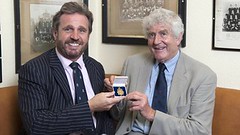 A solid gold medal marking Wales' first Triple Crown win in 1893 has returned to Cardiff after £3,000 was raised to buy it from its owner Down Under.
A solid gold medal marking Wales' first Triple Crown win in 1893 has returned to Cardiff after £3,000 was raised to buy it from its owner Down Under.
THE BOOK BAZARRE
BANK OF ENGLAND TO RELEASE POLYMER BANKNOTES IN 2016
NEW 'QUANTUM' SENSOR DETECTS COUNTERFEIT BANKNOTES
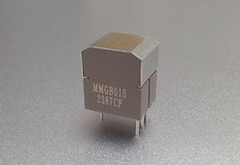 China's MultiDimension Technology has launched a new range of magnetic pattern recognition sensors designed for use in validating banknotes.
China's MultiDimension Technology has launched a new range of magnetic pattern recognition sensors designed for use in validating banknotes.
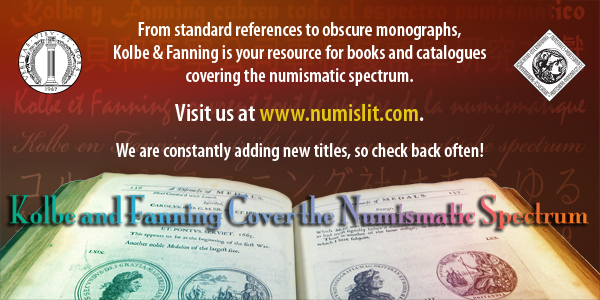
STUDY WARNS OF NICKEL ALLERGY AND NEW ROYAL MINT COINS
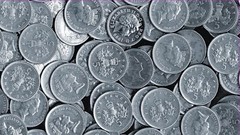 Tests suggest people with a nickel allergy can be at increased risk when handling the UK's new 5p and 10p coins.
Tests suggest people with a nickel allergy can be at increased risk when handling the UK's new 5p and 10p coins.
THE SHEKEL WINS FIRST PLACE SPECIALTY CLUB PUBLICATION AWARD
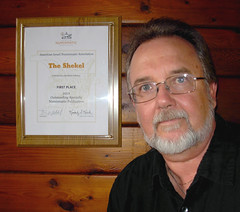 Andrew Perala, is so proud of the First Place Award for Outstanding Publication of a Specialty Coin Club, recently presented by the American Numismatic Association, that he hung it prominently on the wall in his living room. This wouldn’t be so noteworthy, but for the fact that Perala has never hung any other award, not even the Pulitzer Prize or the Investigative Reporting Award from the Society of Professional Journalists, both won in 1989. Perala won as editor of The Shekel, the bimonthly magazine published by the American Israel Numismatic Association since 1968.
Andrew Perala, is so proud of the First Place Award for Outstanding Publication of a Specialty Coin Club, recently presented by the American Numismatic Association, that he hung it prominently on the wall in his living room. This wouldn’t be so noteworthy, but for the fact that Perala has never hung any other award, not even the Pulitzer Prize or the Investigative Reporting Award from the Society of Professional Journalists, both won in 1989. Perala won as editor of The Shekel, the bimonthly magazine published by the American Israel Numismatic Association since 1968.
WAYNE'S NUMISMATIC DIARY: SEPTEMBER 15, 2013
Roger Burdette handed me a new shrink-wrapped copy of the Spring 2013 Issue 2 of his Journal of Numismatic Research - look for more information in a future issue of The E-Sylum. Teaser: it's about Benjamin Franklin Peale. Thanks, Roger!
For me, the highlight of the evening was seeing David Schenkman's Zerbe medal, which was awarded to him at last month's American Numismatic Association convention. The organization's highest honor, it is well deserved. Dave is a tireless worker for the hobby and a fountain of numismatic knowledge. I had never seen the actual medal before, and it's impressive. Dave kindly provided these photos.

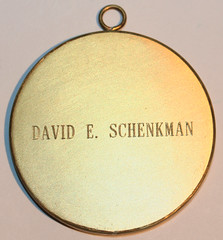
For a theme this month, I'd suggested "Starter Coins" - coins that caught your eye and helped start you along the path to numismatics. I dug some old friends out of the bank for the meeting. First, I had two Whitman folders - the Lincoln Cent Number One (1909-1940) and Canadian Small Cents (1920 to Date).
New purchases are also a common sight at our meetings, and Aaron Packard brought along several lots purchased in one of the recent Stacks Bowers Ford sales. He writes:
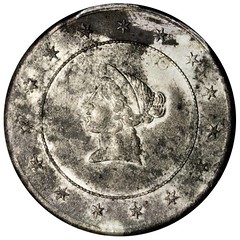
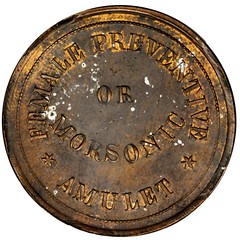
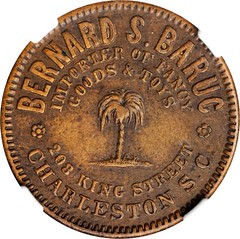
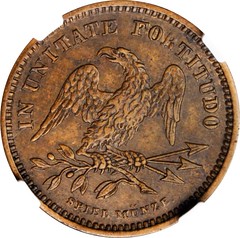
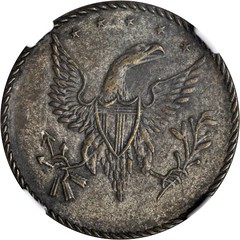

FEATURED WEB PAGE: COINS OF LAOS
This week's Featured Web Page is the OmniCoin section on the coins of Laos.

www.omnicoin.com/country/Laos

